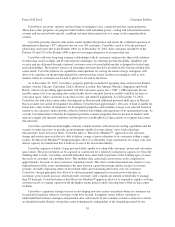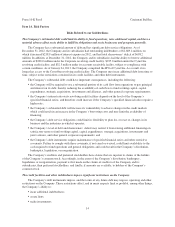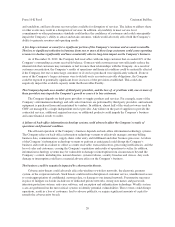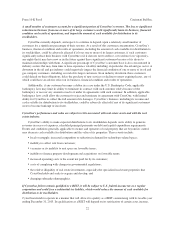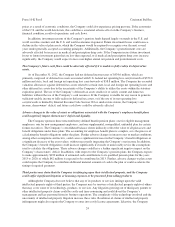Cincinnati Bell 2012 Annual Report Download - page 88
Download and view the complete annual report
Please find page 88 of the 2012 Cincinnati Bell annual report below. You can navigate through the pages in the report by either clicking on the pages listed below, or by using the keyword search tool below to find specific information within the annual report.Item 1A. Risk Factors
Risks Related to our Indebtedness
The Company’s substantial debt could limit its ability to fund operations, raise additional capital, and have a
material adverse effect on its ability to fulfill its obligations and on its businesses and prospects generally.
The Company has a substantial amount of debt and has significant debt service obligations. As of
December 31, 2012, the Company and its subsidiaries had outstanding indebtedness of $2,689.4 million, on
which it incurred $218.9 million of interest expense in 2012, and had total shareowners’ deficit of $698.2
million. In addition, at December 31, 2012, the Company and its subsidiaries had the ability to borrow additional
amounts of $200.0 million under the Corporate revolving credit facility, $225.0 million under the CyrusOne
revolving credit facility, and $32.3 million under its accounts receivable facility, subject to compliance with
certain conditions. As of January 24, 2013, the Company completed the IPO of CyrusOne. As a result, it no
longer has access to the CyrusOne revolving credit facility. The Company may incur additional debt from time to
time, subject to the restrictions contained in its credit facilities and other debt instruments.
The Company’s substantial debt could have important consequences, including the following:
•the Company will be required to use a substantial portion of its cash flow from operations to pay principal
and interest on its debt, thereby reducing the availability of cash flow to fund working capital, capital
expenditures, strategic acquisitions, investments and alliances, and other general corporate requirements;
•the Company’s interest rate on its revolving credit facilities depends on the level of the Company’s
specified financial ratios, and therefore could increase if the Company’s specified financial ratios require a
higher rate;
•the Company’s substantial debt will increase its vulnerability to adverse changes in the credit markets
which could result in an increase in the Company’s borrowing costs and may limit the availability of
financing;
•the Company’s debt service obligations could limit its flexibility to plan for, or react to, changes in its
business and the industries in which it operates;
•the Company’s level of debt and shareowners’ deficit may restrict it from raising additional financing on
satisfactory terms to fund working capital, capital expenditures, strategic acquisitions, investments and
joint ventures, and other general corporate requirements; and
•the Company’s debt instruments require maintenance of specified financial ratios and other restrictive
covenants. Failure to comply with these covenants, if not cured or waived, could limit availability to the
cash required to fund operations and general obligations and could result in the Company’s dissolution,
bankruptcy, liquidation, or reorganization.
The Company’s creditors and preferred stockholders have claims that are superior to claims of the holders
of the Company’s common stock. Accordingly, in the event of the Company’s dissolution, bankruptcy,
liquidation, or reorganization, payment is first made on the claims of creditors of the Company and its
subsidiaries, then preferred stockholders, and finally, if amounts are available, to holders of the Company’s
common stock.
The credit facilities and other indebtedness impose significant restrictions on the Company.
The Company’s debt instruments impose, and the terms of any future debt may impose, operating and other
restrictions on the Company. These restrictions affect, and in many respects limit or prohibit, among other things,
the Company’s ability to:
•incur additional indebtedness;
•create liens;
•make investments;
14
Form 10-K Part I Cincinnati Bell Inc.








